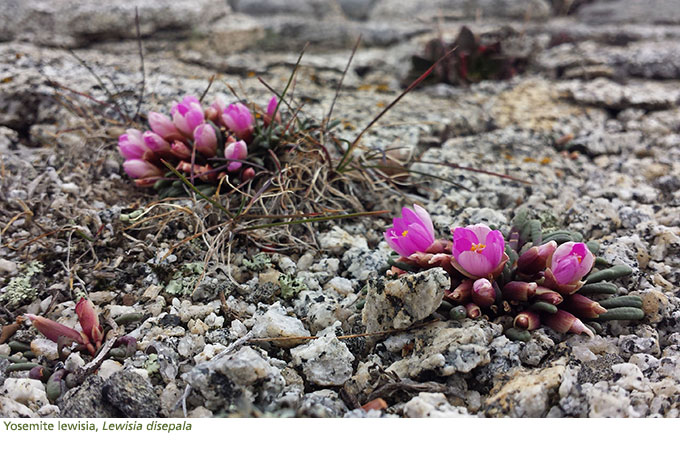When visitors ask "when will the first wildflowers be blooming?" an easy answer is May, June, or July. Wildflowers will blanket meadows and hillsides, adding pigments and fragrance to the already majestic landscape that Yosemite National Park is known for. However, months before the poppies, pentstemons, lilies, and shooting stars show their pretty summer colors to the world, a small, special flower grows high up in seemingly harsh conditions.

The Yosemite lewisia, Lewisia disepala, is a petite perennial herb of the purslane family. One of several specialized wildflower species, it grows in talus areas and shallow beds of gravel on granite domes. In late spring to mid-summer these flowers lay dormant while other flowering species are thriving. As autumn rains come in, the lewisias sprout their thick, shiny green leaves. Throughout the winter, lewisias photosynthesize under the snow where the ground is not frozen, encapsulated in a "cold greenhouse." Once the snow above them melts out and the ground warms during the day, the plants develop buds and flowers quite quickly because they already have several months of growth under their belts. Small pink flowers can show their faces as early as February at lower elevation sites! These flowers open each day to entice pollinating bees to visit, and close again at night. Lewisias will dry up and disappear back into their shallow gravel hideaways from May to July and start their yearly growth cycle all over again.
The Yosemite lewisia is endemic to the Yosemite region of the Sierra Nevada; they do not exist anywhere else in the world. They are on the Yosemite National Park sensitive plants list. Because their life cycle depends on weather so much, and weather can be all but predictable, park botanists keep a close eye on lewisias. For example, park staff are watchful for pollinating insects and whether or not the insects' and flowers' symbiotic relationship remains in sync. The lewisia's preferred place to grow, shallow beds of gravel, can be precarious as well. The gravel these plants live in may only be an inch deep, and the pressure of a hiker's boot could crush a dormant lewisia rootstock. So next time you're walking on Yosemite's domes, keep your feet on the bedrock and your eyes on the gravel.
